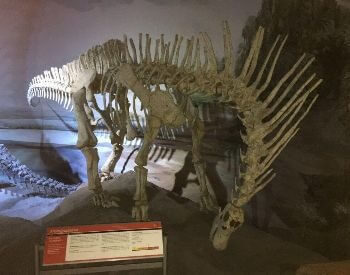
- Species Type: Amargasaurus cazaui
- Type of Dinosaur: Sauropod
- Period: Early Cretaceous
- Diet: Vegetation (herbivorous)
- Length: Between 30 and 33 feet
- Weight: 2.8 tons (average)
- First Discovered: 1984
19 Amargasaurus Facts for Kids
- The Amargasaurus was discovered by Guillermo Rougier in 1984.
- The Amargasaurus was discovered in the La Amarga Formation (Argentina, South America).
- The Amargasaurus got its scientific name Amargasaurus cazaui in 1991, from Leonardo Salgado and Jose Bonaparte.
- The name Amargasaurus means: “La Amarga lizard”.
- The name Amargasaurus is pronounced: “ah-MAR-guh-SAWR-us”.
- The Amargasaurus was part of a group of dinosaurs known as sauropods.
- Amargasaurus lived during the Early Cretaceous Period, between 129.4 and 122.46 million years ago.
- Paleontologists only recognize one species of Amargasaurus and that is Amargasaurus cazaui.
- The Amargasaurus was an herbivore that ate vegetation and paleontologists believe the Amargasaurus fed on vegetation from trees.
- Estimates put the average length of an Amargasaurus between 30 and 33 feet.
- Estimates put the average weight of an Amargasaurus around 2.8 tons.
- The Amargasaurus was a large dinosaur but is still considered small of a sauropod.
- The Amargasaurus is most recognizable by the two rows of spines that ran down its neck and back.
- Paleontologists don’t know what the purpose of the spines were on the Amargasaurus.
- Paleontologists don’t know if the spines on the Amargasaurus were covered in a layer of skin or exposed bare.
- Paleontologists think the spines on the Amargasaurus might have been used as a defense against predators, to absorb heat from the sun, a way to recognize each other, a display used in courtship or used to make loud noises.
- There has only been one recovered fossil of an Amargasaurus and that is specimen number MACN-N 15.
- The recovered Amargasaurus specimen MACN-N 15 was almost entirely complete.
- The Amargasaurus walked on all four legs (quadrupedal) and paleontologists don’t believe it was able to stand up (rear) on its hind legs.
Amargasaurus Pictures

A picture of a Amargasaurus skeleton in a museum.Credit: Kuminko / Flickr

A picture of an Amargasaurus exhibit in a museum.Credit: Phil Mannion

A picture of an Amargasaurus display in a museum.Credit: Serjoscha Evers

A picture of a Amargasaurus drinking some water.Credit: Ghetty Images

A picture of a Amargasaurus near a big predator.Credit: Ghetty Images

A picture of a Amargasaurus’s tail from the back.Credit: Ghetty Images
Additional Resources on Amargasaurus
- Amargasaurus – Natural History Museum UK – Discover more facts about the Amargasaurus on the UK Natural History Museum website.
- Amargasaurus – Western Australian Museum – Learn about the Amargasaurus on the Western Australian Museum website.
- Amargasaurus – Wikipedia – Find more cool facts about the Amargasaurus on the Wikipedia website.
